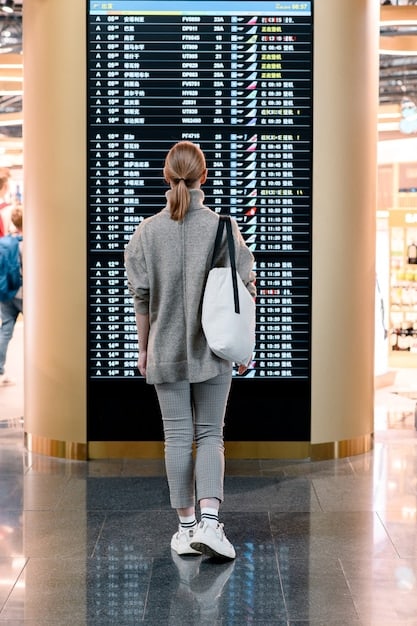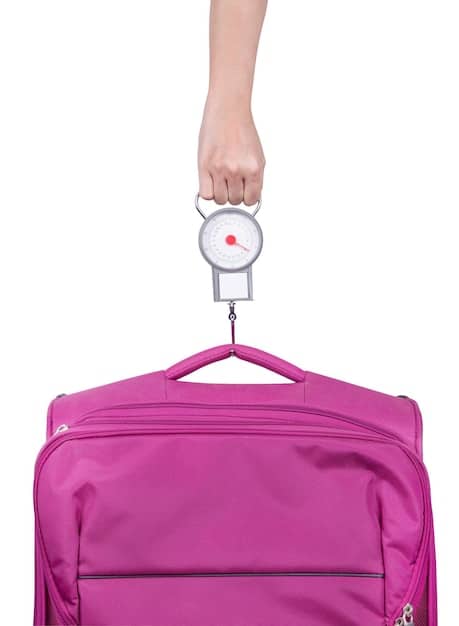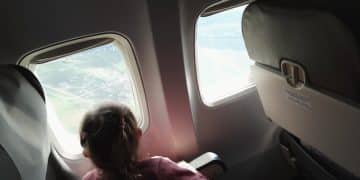US Airlines Baggage Fee Hikes: What Travelers Need to Know

Navigating the evolving landscape of travel costs, US airlines are considering potential baggage fee increases, a move that could significantly impact your travel budget, making it crucial for passengers to understand these changes and adapt their planning strategies accordingly to avoid unexpected expenses.
As the holiday season approaches and travel demand soars, a looming concern for many travelers is the potential for increased airline fees. Specifically, the news around US Airlines Face Potential Baggage Fee Hikes: How Will This Affect Your Travel Budget? has caught the attention of budget-conscious flyers, prompting a closer look into what these changes might entail and how passengers can prepare for them.
The Evolving Landscape of Airline Ancillary Fees
Airline ancillary fees have become a significant revenue stream for carriers over the past two decades. These charges, spanning everything from seat selection to in-flight meals, have transformed the basic act of flying into a more fragmented, à la carte experience. Baggage fees, in particular, have been a prime example of this trend, often surprising unsuspecting travelers at the airport counter.
Initially introduced as a way to offset rising fuel costs and encourage lighter packing, baggage fees have steadily climbed, becoming a widely accepted, albeit frequently lamented, part of the air travel equation. The ongoing discussions about potential new hikes suggest that airlines are continually seeking ways to optimize their profitability, often passing on operational costs or market-driven pricing adjustments directly to the consumer.
Historical Context of Baggage Fees
Understanding the present requires a look at the past. Baggage fees first gained widespread traction in the US in the late 2000s, largely propelled by economic downturns and a shift in airline business models. What started as charges for checked bags, particularly for economy class tickets, rapidly expanded to include second checked bags, oversized items, and even carry-on bags on some ultra-low-cost carriers.
This historical progression illustrates a clear pattern: once a new fee is introduced and accepted by the market, it tends to become a permanent fixture, often subject to incremental increases over time. The push for new or higher baggage fees aligns with this established precedent, underscoring airlines’ consistent drive to maximize non-ticket revenue, which now constitutes a substantial portion of their overall earnings.
- 2008 & Beyond: Introduction of first checked bag fees by major US airlines.
- Variable Pricing: Fees began to vary by route, elite status, and credit card affiliation.
- Carry-On Controversy: Some airlines started charging for carry-on luggage, especially basic economy.
- Steady Increases: Regular, often unannounced, small increases in existing baggage fees.
The current discussions represent another potential chapter in this ongoing narrative. Airlines often justify these adjustments by citing inflationary pressures, increased operational expenses, or investments in passenger services, though the direct benefits to passengers from such increases are often less clear. These potential hikes are not just isolated incidents; they reflect a broader strategy influencing the entire travel industry.
For travelers, this means a constant need to stay informed and adapt their packing strategies. What might have been a minor nuisance, a $25 checked bag fee, could soon become a more substantial financial burden, pushing the total cost of a trip significantly higher than initially anticipated when booking the base fare.
Decoding the Potential Increases: What’s on the Table?
When discussions about fee hikes emerge, details are often sparse initially, leading to speculation and concern. However, industry insiders and financial analysts closely monitor these trends, offering insights into what might actually be “on the table” for US airlines regarding baggage fees. These potential increases are rarely uniform across all carriers but often trigger a ripple effect if one major airline makes a move.
One primary consideration for airlines contemplating fee adjustments is market competitiveness. While each airline seeks to maximize its revenue, there’s a delicate balance to strike to avoid deterring passengers who might opt for a competitor if their fees become excessively high. However, if multiple major carriers move in a similar direction, the collective impact on consumers can be substantial.
Reasons Behind the Proposed Hikes
Airlines typically cite several reasons when considering fee increases. Understanding these justifications, whether passengers agree with them or not, provides insight into the industry’s economic pressures:
- Inflationary Pressures: The rising cost of labor, fuel, and airport operational expenses directly impacts airline profitability.
- Infrastructure Investments: Airlines often claim new fees help fund upgrades to fleets, technology, and gate facilities.
- Passenger Behavior Modification: Higher fees for checked bags can encourage lighter packing, potentially reducing fuel consumption and speeding up boarding.
- Revenue Optimization: Maximizing non-ticket revenue streams remains a core business strategy, especially as base fares face competitive pressure.
It’s important to note that these “reasons” are the airline’s perspective. For the consumer, the immediate reality is a higher cost of travel. The potential increases might manifest in various ways: a flat increase across all baggage fees, a new tiered system based on weight or destination, or perhaps even charges for items previously exempt. The precise nature of these changes will greatly determine their impact on different traveler segments.
Another factor often overlooked is the psychological effect on travelers. When a base fare seems low, but ancillary fees quickly add up, the initial positive impression can turn into frustration. Airlines are generally aware of this but weigh it against their financial imperatives. Therefore, any fee hike is likely a carefully calculated decision, balancing potential passenger backlash with revenue goals.
Staying informed about specific announcements from individual airlines is crucial. While general news points to “potential hikes,” the devil is always in the details of how each airline chooses to implement new or increased charges. Travelers should monitor official airline communications and reputable travel news sources for the most accurate and up-to-date information.
Impact on Your Travel Budget: A Realistic Look
For many, particularly leisure travelers and families, baggage fees represent a tangible additional cost that directly impacts the overall travel budget. A seemingly small increase of $5-$10 per bag can quickly escalate, especially for longer trips or those involving multiple family members. This section will explore the realistic financial implications of potential baggage fee hikes.
Consider a family of four taking a week-long vacation. If each person checks one bag, even a modest $5 increase per bag transforms into an extra $40 for the round trip. For a budget already tight, this can necessitate cutbacks elsewhere, perhaps on dining, activities at the destination, or souvenir purchases. The cumulative effect across millions of travelers annually is substantial for the airlines.
Calculating the Cumulative Cost
The total impact of baggage fees often gets overlooked during the initial flight booking process, where the focus is primarily on the base fare. However, a realistic travel budget must account for all potential charges. With potential hikes, this calculation becomes even more critical.
- Single Traveler: One checked bag might see a $5-$10 increase.
- Couple: Two checked bags could mean a $10-$20 increase.
- Family of Four: With four checked bags, the increase could easily range from $20-$40 per round trip.
- Specialty Items: Golf clubs, skis, or other oversized items, already subject to higher fees, could see even steeper increases.

This adds up quickly, especially when considering transatlantic or transcontinental flights where baggage fees might already be higher. Moreover, these fees are generally upfront and non-negotiable once incurred, unlike some other travel expenses that might offer flexibility.
Beyond the direct financial cost, there’s also the psychological cost of feeling “nickeled and dimed.” This can detract from the overall travel experience, creating a sense of resentment rather than excitement. Travelers often express frustration when the final cost of a flight far exceeds the advertised base fare, primarily due to the accumulation of ancillary charges.
Therefore, when budgeting for upcoming travel, it’s prudent to assume that current baggage fees are a floor, not a ceiling. Building in a small buffer for potential increases or actively seeking ways to mitigate these costs becomes a sensible strategy. Proactive planning can make a significant difference in preventing budget overruns and ensuring a smoother travel experience when fee hikes are a real possibility.
Strategies for Minimizing Baggage Expenses
Faced with the prospect of increased baggage fees, travelers are increasingly looking for smart strategies to minimize these expenses. While some fees are unavoidable, many can be significantly reduced or even eliminated with careful planning and awareness of airline policies. Proactive measures are key to keeping your travel budget intact.
One of the most effective strategies is simply to pack lighter. This might seem obvious, but the discipline required to streamline your packing list can yield substantial savings. Understanding your airline’s specific baggage allowance and weight limits before you even start packing is crucial, as exceeding these limits can trigger even higher surcharges.
Leveraging Airline-Specific Perks and Policies
Many airlines offer ways to bypass or reduce baggage fees, often tied to their loyalty programs, co-branded credit cards, or specific fare classes. Exploring these options can provide significant long-term savings for frequent flyers.
- Co-branded Credit Cards: Many airline credit cards offer perks like a free first checked bag for the cardholder and companions on the same reservation. This benefit alone can often offset the annual fee of the card.
- Airline Elite Status: Loyalty program members with elite status often receive complimentary checked baggage allowances, sometimes even for multiple bags.
- Basic Economy Caveats: Be aware that basic economy fares typically have the most restrictive baggage policies, often charging for carry-on bags where standard economy does not. Opting for a slightly higher fare class might save money on baggage fees in some cases.
- Military Personnel: Active duty military personnel often receive generous complimentary baggage allowances from major airlines.
Beyond these specific perks, strategic packing remains paramount. Using packing cubes, rolling clothes, and wearing bulkier items onto the plane can help maximize space and avoid overweight bag charges. For shorter trips, a carry-on-only approach is the ultimate fee-saving strategy, provided you adhere to the airline’s specific carry-on dimensions and weight limits.
Consider shipping luggage for longer trips or when carrying specialized equipment. While this incurs a cost, it can sometimes be more economical than paying multiple oversized or overweight baggage fees, especially for families or large groups. This option also offers the convenience of not having to lug heavy bags through airports.
Finally, always double-check your airline’s most current baggage policy just before your trip. Policies can change without extensive public announcement, and what was true last year might not be true today. A few minutes of research can save you significant dollars and headaches at the airport check-in counter.
The Broader Economic Context: Why Fees Are on the Rise
Understanding why US airlines are exploring potential baggage fee hikes requires looking beyond simple profitability and considering the broader economic context in which they operate. The airline industry is highly susceptible to external shocks, from fuel price volatility to global economic downturns and, most recently, the lingering effects of a global pandemic.
Despite a rebound in passenger demand, airlines face persistent inflationary pressures on various fronts. The cost of jet fuel, while fluctuating, remains a significant operational expense. Labor costs, reflecting a competitive employment market and union negotiations, are also on an upward trajectory. Additionally, fees associated with airport operations, navigation services, and maintenance are continuously rising.
Market Dynamics and Competitive Pressures
The airline industry is fiercely competitive, particularly within the US domestic market. While some consolidation has occurred, airlines still vie for market share, which often keeps base fares relatively low. This competitive pressure on ticket prices makes ancillary fees an even more critical component of an airline’s financial health.
The “unbundling” of air travel services, where the basic fare only covers transportation, and all extras are charged separately, gained traction as airlines sought to offer lower headline prices to attract budget-conscious travelers. Baggage fees are a prime example of this model. They allow airlines to advertise a lower price point while generating substantial revenue from services many passengers ultimately require.
Furthermore, investor expectations play a significant role. Airlines are publicly traded companies, and their financial performance is under constant scrutiny. Increasing ancillary revenue streams, like baggage fees, is often seen as a way to improve profit margins and demonstrate financial resilience, satisfying shareholders.
The airline industry also invests heavily in fleet modernization, technology upgrades, and customer service initiatives. Airlines often argue that revenue from ancillary fees helps fund these improvements, which in turn benefit passengers through newer aircraft, better in-flight entertainment, and more efficient operations. However, the direct correlation is not always clear to the average traveler.
In essence, the potential baggage fee hikes are a complex response to a multifaceted economic environment. They reflect a combination of rising operational costs, intense market competition, shareholder demands for profitability, and an established business model that relies heavily on unbundled services. Travelers, therefore, find themselves navigating an environment where the full cost of their journey requires careful consideration beyond the initial ticket price.
Preparing for the Future: What Travelers Should Do Now
In an environment where baggage fee increases are a distinct possibility, proactive preparation is the traveler’s best defense against unexpected costs and potential budget overruns. Adopting a strategic mindset now can significantly ease future travel planning and financial management, whether you’re traveling for leisure or business.
The most immediate and impactful action is to cultivate a habit of checking specific airline policies well in advance of booking. Do not assume that baggage policies remain static. What was true for your last flight might have changed for your next. Airlines are not always transparent in announcing fee changes broadly, often integrating them into their terms and conditions, which requires diligent checking.
Practical Steps for Smart Travel Planning
Beyond simply checking policies, several practical steps can empower travelers to navigate the evolving fee landscape more effectively:
- Budget Buffer: Always allocate a buffer in your travel budget specifically for potential ancillary fees, even if you don’t plan to incur them. This provides a safety net if last-minute changes or unexpected charges arise.
- Price Comparison Tools: When comparing flights, do not just look at the base fare. Utilize flight comparison websites that allow you to include estimates for baggage fees in the total cost. Some modern tools are becoming better at providing a more comprehensive “all-in” price.
- Consider Carry-On Only: For shorter trips, commit to a carry-on-only strategy. Invest in a high-quality, lightweight carry-on suitcase that maximizes space within airline dimension limits. This eliminates checked baggage fees entirely.
- Loyalty Programs & Credit Cards: If you frequently fly with a specific airline, investigate their loyalty program and co-branded credit cards. The benefits, such as free checked bags, priority boarding, or lounge access, might outweigh the annual fee, especially if you travel multiple times a year.
- Review Packing Habits: Regularly review and optimize your packing methods. Learn about minimalist packing, capsule wardrobes, and space-saving techniques. Every pound saved can translate to dollars saved if you avoid overweight charges.
Educating yourself on the dynamics of airline pricing and being prepared for adjustments is essential. This includes understanding the difference between various fare classes (e.g., basic economy vs. standard economy) and how each impacts baggage allowances. Sometimes, paying a slightly higher base fare for a standard economy ticket might be cheaper overall than a basic economy ticket combined with baggage fees.
Furthermore, consider purchasing travel insurance that might offer some coverage for baggage-related issues, although this typically pertains to lost or delayed luggage rather than direct fee reimbursement. The key takeaway is to approach air travel with an informed and adaptive mindset. The landscape of airline fees is constantly shifting, and staying agile in your planning is the best way to protect your travel budget from future increases.
The Future of Airline Pricing: More Unbundling Ahead?
The potential for US airlines to increase baggage fees is not an isolated incident but rather a signal of broader trends shaping the future of airline pricing. The past decade has seen a dramatic shift towards unbundling, where the basic airfare covers only the seat, and almost everything else is an additional, charged-for service. This model allows airlines to present a lower headline price, appealing to competitive pressures, while recouping revenue through ancillary services.
It’s plausible that this unbundling trend will continue, with airlines exploring new categories of services to monetize. While some services, like Wi-Fi or premium snacks, are clearly optional, others, like baggage, have become almost essential for many travelers, turning what was once included into a mandatory extra. This approach shifts the burden of cost management increasingly onto the consumer.
Anticipating New Ancillary Charges
What might the future hold beyond existing baggage fees? While speculative, airlines may continue to experiment with various fee structures, influenced by technology, changing traveler preferences, and competitive dynamics. Potential areas for future monetization could include:
- Time-Based Fees: Charges for priority check-in or specific boarding groups could become more common or expensive.
- Dynamic Pricing for Seats: Moving beyond simple exit row charges to more granular pricing based on seat location within the cabin (e.g., window vs. aisle, front vs. back), dynamically adjusting based on demand.
- Advanced Check-in Fees: While rare, a fee for checking in very early or very late could emerge if automation reduces the need for human interaction.
- Access to Amenities: Separate charges for access to specific airport lounge areas or even faster security lines for economy passengers.
The evolution of airline pricing is not just about airlines seeking more revenue; it’s also about leveraging data to understand passenger behavior and willingness to pay. Airlines collect vast amounts of data on booking patterns, ancillary purchases, and passenger demographics, allowing them to optimize pricing strategies to maximize yield. This sophisticated data analysis further refines the “unbundled” model.
For travelers, this means a continuous need for vigilance and adaptation. The days of a simple ticket price covering all essential services are largely behind us. The future of airline pricing is likely to be highly personalized, with dynamic pricing and a plethora of optional add-ons, requiring travelers to be more proactive in comparing total costs, not just base fares.
Ultimately, the industry’s direction is toward greater transparency in breaking down costs, even if the total sum is higher. While this provides passengers with choices, it also places a greater responsibility on them to understand their needs and select services accordingly. The potential for US airlines to increase baggage fees is a clear indicator that the era of budget-conscious, à la carte travel is here to stay, and likely to expand.
| Key Point | Brief Description |
|---|---|
| 💸 Fee Hikes Imminent | US airlines are likely to increase baggage fees, impacting overall travel costs significantly. |
| 💡 Budget Adjustment | Travelers must incorporate potential fee increases into their budget planning to avoid surprises. |
| 🎒 Smart Packing | Light packing and using airline credit card perks are key strategies to minimize expenses. |
| 📈 Broader Trend | Fee hikes reflect wider economic pressures and the airline industry’s ongoing unbundling strategy. |
Frequently Asked Questions About Baggage Fees
▼
Airlines often cite rising operational costs like fuel, labor, and airport fees. Increased ancillary revenue also helps them improve profitability and invest in infrastructure amidst competitive pressure and shareholder demands for better financial performance after periods of economic strain.
▼
The most accurate way is to check your specific airline’s official website directly. Baggage policies can vary by fare class, destination, and frequent flyer status. These fees are typically updated regularly, so always check close to your booking or departure date for the most current information.
▼
Yes, many strategies exist. These include packing light enough for a carry-on-only trip, utilizing co-branded airline credit cards that offer free checked bags, attaining elite status with an airline’s loyalty program, or flying certain fare classes where baggage is included in the ticket price.
▼
Not necessarily. While basic economy fares often bear the brunt, travelers with elite status, specific airline credit cards, or those purchasing first/business class tickets might be exempt or have more generous allowances. Families or those on longer trips will likely feel the financial impact more significantly due to multiple bags.
▼
Unbundling refers to the airline practice of separating services once included in the base fare—like checked bags, seat selection, or inflight meals—and charging for them individually. This allows airlines to offer lower base fares competitively while generating additional revenue from these optional or necessary add-ons.
Conclusion: Adapting to the New Reality of Air Travel
The discussions surrounding potential baggage fee hikes by US airlines serve as a stark reminder of the evolving nature of air travel costs. As an integral component of the airline’s ancillary revenue strategy, these fees are not merely an inconvenience but a significant factor in overall travel budgeting. Travelers must adopt a proactive, informed approach, embracing strategies like lighter packing, leveraging airline loyalty programs, and carefully assessing all-in costs before booking. The future of airline pricing seems poised for continued unbundling, placing greater onus on the consumer to navigate a complex array of choices and charges. By staying vigilant and adaptable, travelers can mitigate the impact of these changes, ensuring their journeys remain both enjoyable and financially viable in this dynamic landscape.





